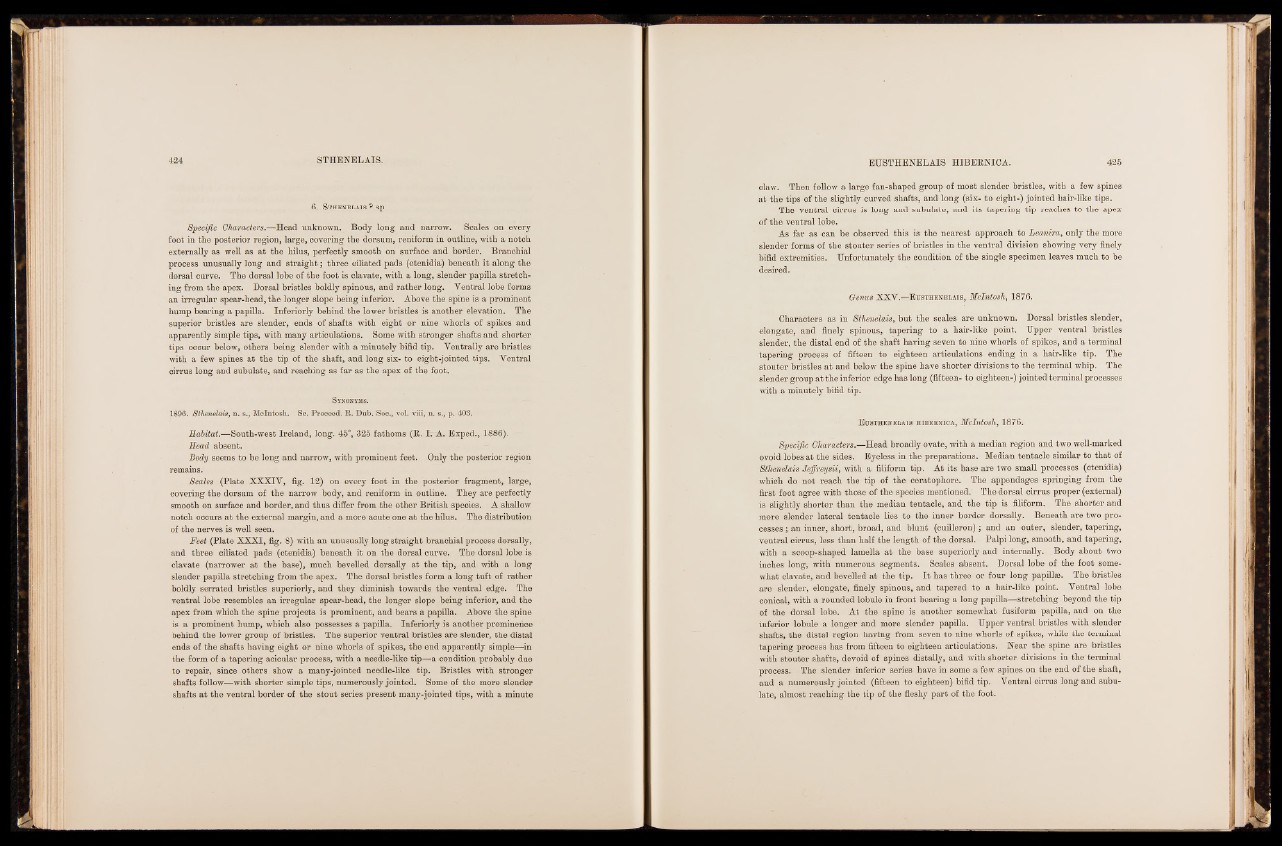
6. S thenelais ? sp .
Specific Characters.—Head unknown. Body long and narrow. Scales on every
foot in the posterior region, large, covering the dorsum, reniform in outline, with a notch
externally as well as at the hilus, perfectly smooth on surface and border. Branchial
process unusually long and straight; three ciliated pads (ctenidia) beneath it along the
dorsal curve. The dorsal lobe of the foot is clavate, with a long, slender papilla stretching
from the apex. Dorsal bristles boldly spinous, and rather long. Ventral lobe forms
an irregular spear-head, the longer slope being inferior. Above the spine is a prominent
hump bearing a papilla. Inferiorly behind the lower bristles is another elevation. The
superior bristles are slender, ends of shafts with eight or nine whorls of spikes and
apparently simple tips, with many articulations. Some with stronger shafts and shorter
tips occur below, others being slender with a minutely bifid tip. Ventrally are bristles
with a few spines at the tip of the shaft, and long six- to eight-jointed tips. Ventral
cirrus long and subulate, and reaching as far as the apex of the foot..
S yno nyms.
1896. Sthenelais, n. s., McIntosh. Sc. Proceed. R. Dub. Soc., vol. viii, n. s., p. 403.
Habitat.—South-west Ireland, long. 45°, 325 fathoms (R. I. A. Exped., 1886).
Head absent.
Body seems to be long and narrow, with prominent feet. Only the posterior region
remains.
Scales (Plate XXXIV, fig. 12) on every foot in the posterior fragment, large,
covering the dorsum of the narrow body, and reniform in outline. They are perfectly
smooth on surface and border, and thus differ from the other British species. A shallow
notch occurs at the external margin, and a more acute one at the hilus. The distribution
of the nerves is well seen.
Feet (Plate XXXI, fig. 8) with an unusually long straight branchial process dorsally,
and three ciliated pads (ctenidia) beneath it on the dorsal curve. The dorsal lobe is
clavate (narrower at the base), much bevelled dorsally at the tip, and with a long
slender papilla stretching from the apex. The dorsal bristles form a long tuft of rather
boldly serrated bristles superiorly, and they diminish towards the ventral edge. The
ventral lobe resembles an irregular spear-head, the longer slope being inferior, and the
apex from which the spine projects is prominent, and bears a papilla. Above the spine
is a prominent hump, which also possesses a papilla. Inferiorly is another prominence
behind the lower group of bristles. The superior ventral bristles are slender, the distal
ends of the shafts having eight or nine whorls of spikes, the end apparently simple—in
the form of a tapering acicular process, with a needle-like tip—a condition probably due
to repair, since others show a many-jointed needle-like tip. Bristles with stronger
shafts follow—with shorter simple tips, numerously jointed. Some of the more slender
shafts at the ventral border of the stout series present many-jointed tips, with a minute
claw. Then follow a large fan-shaped group of most slender bristles, with a few spines
at the tips of the slightly curved shafts, and long (six- to eight-) jointed hair-like tips.
The ventral cirrus is long and subulate, and its tapering tip reaches to the apex
of the ventral lobe.
As far as can be observed this is the nearest approach to Leanira, only the more
slender forms of the stouter series of bristles in the ventral division showing very finely
bifid extremities. Unfortunately the condition of the single specimen leaves much to be
desired.
Genus XXV.—E usthenelais, McIntosh, 1876.
Characters as in Sthenelais, but the scales are unknown. Dorsal bristles slender,
elongate, and finely spinous, tapering to a hair-like point. Upper ventral bristles
slender, the distal end of the shaft having seven to nine whorls of spikes, and a terminal
tapering process of fifteen to eighteen articulations ending in a hair-like tip. The
stouter bristles at and below the spine have shorter divisions to the terminal whip. The
slender group at the inferior edge has long (fifteen- to eighteen-) jointed terminal processes
with a minutely bifid tip.
E usthenelais hibebnioa, McIntosh, 1876-
Specific Characters.—Head broadly ovate, with a median region and two well-marked
ovoid lobes at the sides. Eyeless in the preparations. Median tentacle similar to that of
Sthenelais Jeffrey sii, with a filiform tip. At its base are two small processes (ctenidia)
which do not reach the tip of the ceratophore. The appendages springing from the
first foot agree with those of the species mentioned.' The dorsal cirrus proper (external)
is slightly shorter than the median tentacle, and the tip is filiform. The shorter and
more slender lateral tentacle lies to the inner border dorsally. Beneath are two processes
; an inner, short, broad, and blunt (cuilleron) ; and an outer, slender, tapering,
ventral cirrus, less than half the length of the dorsal. Palpi long, smooth, and tapering,
with a scoop-shaped lamella at the base superiorly and internally. Body about two
inches long, with numerous segments. Scales absent. Dorsal lobe of the foot somewhat
clavate, and bevelled at the tip. I t has three or four long papillae. The bristles
are slender, elongate, finely spinous, and tapered to a hair-like point. Ventral lobe
conical, with a rounded lobule in front bearing a long papilla—stretching beyond the tip
of the dorsal lobe. At the spine is another somewhat fusiform papilla, and on the
inferior lobule a longer and more slender papilla. Upper ventral bristles with slender
shafts, the distal region having from seven to nine whorls of spikes, while the terminal
tapering process has from fifteen to eighteen articulations. Near the spine are bristles
with stouter shafts, devoid of spines distally, and with shorter divisions in the'terminal
process. The slender inferior series have in some a few spines on the end of the shaft,
and a numerously jointed (fifteen to eighteen) bifid tip. Ventral cirrus long and subulate,
almost reaching the tip of the fleshy part of the foot.